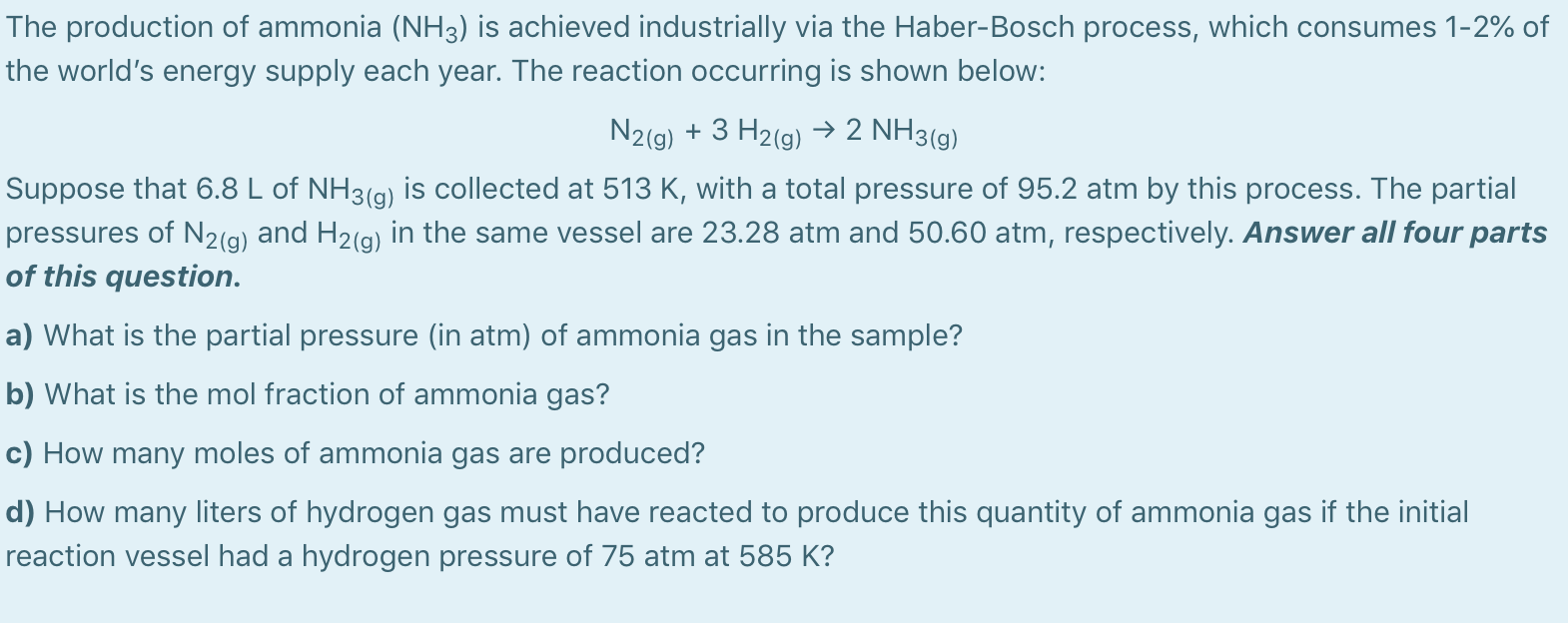The production of ammonia (NH3) is achieved industrially via the Haber-Bosch process, which consumes 1-2% of the world's energy supply each year. The reaction occurring is shown below: N2(g) + 3 H2(g) → 2 NH3(g) Suppose that 6.8 L of NH3(g) is collected at 513 K, with a total pressure of 95.2 atm by this process. The partial pressures of N2(g) and H2(g) in the same vessel are 23.28 atm and 50.60 atm, respectively. Answer all four parts of this question. a) What is the partial pressure (in atm) of ammonia gas in the sample? b) What is the mol fraction of ammonia gas? c) How many moles of ammonia gas are produced? d) How many liters of hydrogen gas must have reacted to produce this quantity of ammonia gas if the initial reaction vessel had a hydrogen pressure of 75 atm at 585 K?
The production of ammonia (NH3) is achieved industrially via the Haber-Bosch process, which consumes 1-2% of the world's energy supply each year. The reaction occurring is shown below: N2(g) + 3 H2(g) → 2 NH3(g) Suppose that 6.8 L of NH3(g) is collected at 513 K, with a total pressure of 95.2 atm by this process. The partial pressures of N2(g) and H2(g) in the same vessel are 23.28 atm and 50.60 atm, respectively. Answer all four parts of this question. a) What is the partial pressure (in atm) of ammonia gas in the sample? b) What is the mol fraction of ammonia gas? c) How many moles of ammonia gas are produced? d) How many liters of hydrogen gas must have reacted to produce this quantity of ammonia gas if the initial reaction vessel had a hydrogen pressure of 75 atm at 585 K?
Chapter5: Gases
Section: Chapter Questions
Problem 152CP: You have an equimolar mixture of the gases SO2 and O2, along with some He, in a container fitted...
Related questions
Question

Transcribed Image Text:The production of ammonia (NH3) is achieved industrially via the Haber-Bosch process, which consumes 1-2% of
the world's energy supply each year. The reaction occurring is shown below:
N2(g) + 3 H2(g) → 2 NH3(g)
Suppose that 6.8 L of NH3(g) is collected at 513 K, with a total pressure of 95.2 atm by this process. The partial
pressures of N2(g) and H2(g) in the same vessel are 23.28 atm and 50.60 atm, respectively. Answer all four parts
of this question.
a) What is the partial pressure (in atm) of ammonia gas in the sample?
b) What is the mol fraction of ammonia gas?
c) How many moles of ammonia gas are produced?
d) How many liters of hydrogen gas must have reacted to produce this quantity of ammonia gas if the initial
reaction vessel had a hydrogen pressure of 75 atm at 585 K?
Expert Solution
This question has been solved!
Explore an expertly crafted, step-by-step solution for a thorough understanding of key concepts.
This is a popular solution!
Trending now
This is a popular solution!
Step by step
Solved in 2 steps with 2 images

Recommended textbooks for you


Chemistry
Chemistry
ISBN:
9781305957404
Author:
Steven S. Zumdahl, Susan A. Zumdahl, Donald J. DeCoste
Publisher:
Cengage Learning

Chemistry: An Atoms First Approach
Chemistry
ISBN:
9781305079243
Author:
Steven S. Zumdahl, Susan A. Zumdahl
Publisher:
Cengage Learning


Chemistry
Chemistry
ISBN:
9781305957404
Author:
Steven S. Zumdahl, Susan A. Zumdahl, Donald J. DeCoste
Publisher:
Cengage Learning

Chemistry: An Atoms First Approach
Chemistry
ISBN:
9781305079243
Author:
Steven S. Zumdahl, Susan A. Zumdahl
Publisher:
Cengage Learning

General Chemistry - Standalone book (MindTap Cour…
Chemistry
ISBN:
9781305580343
Author:
Steven D. Gammon, Ebbing, Darrell Ebbing, Steven D., Darrell; Gammon, Darrell Ebbing; Steven D. Gammon, Darrell D.; Gammon, Ebbing; Steven D. Gammon; Darrell
Publisher:
Cengage Learning

Introductory Chemistry: An Active Learning Approa…
Chemistry
ISBN:
9781305079250
Author:
Mark S. Cracolice, Ed Peters
Publisher:
Cengage Learning

Chemistry: Principles and Practice
Chemistry
ISBN:
9780534420123
Author:
Daniel L. Reger, Scott R. Goode, David W. Ball, Edward Mercer
Publisher:
Cengage Learning